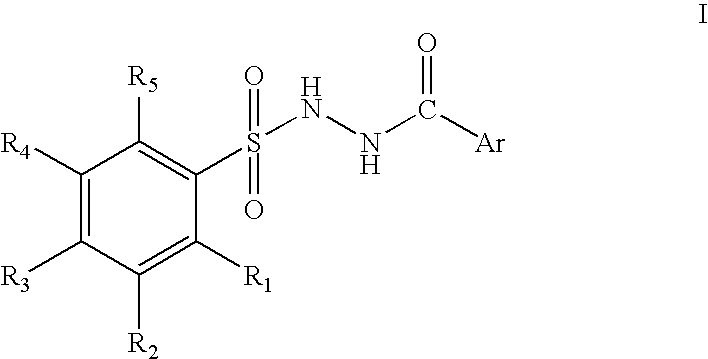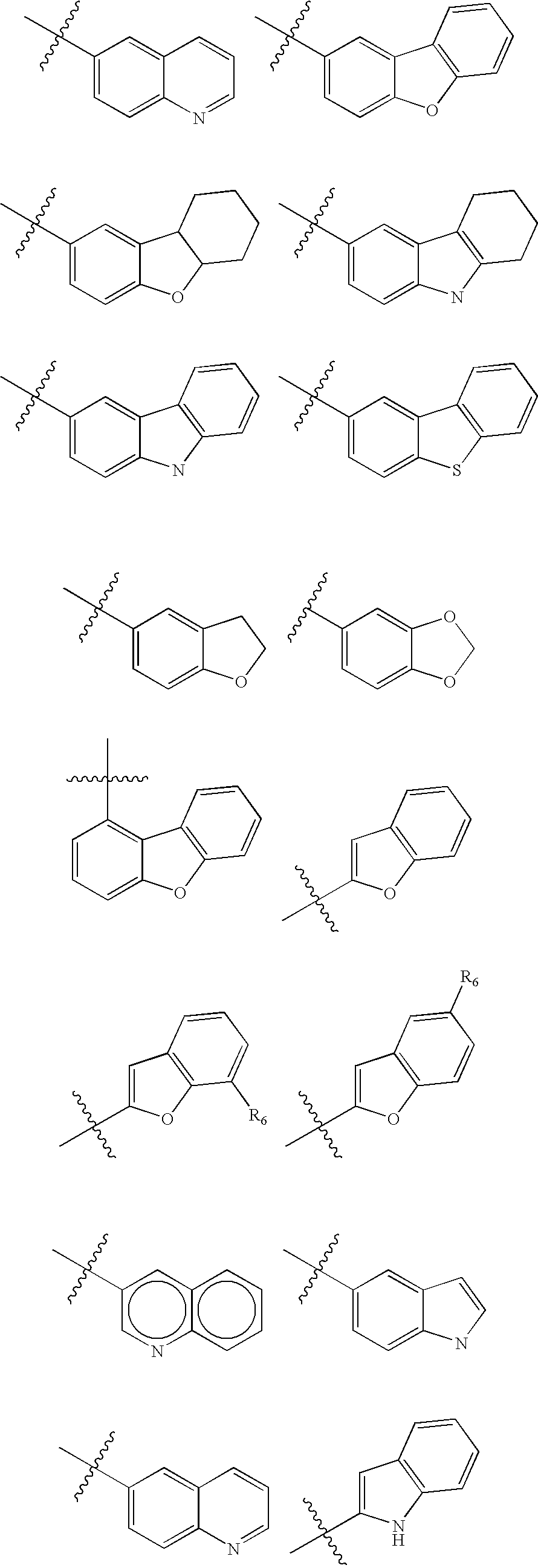Branched chain amino acid-dependent aminotransferase inhibitors and their use in the treatment of neurodegenerative diseases
a technology of aminotransferase and branched chain amino acid, which is applied in the direction of biocide, plant growth regulator, animal husbandry, etc., can solve the problems of neurodegeneration and death, and achieve the effect of preventing neuronal loss
- Summary
- Abstract
- Description
- Claims
- Application Information
AI Technical Summary
Benefits of technology
Problems solved by technology
Method used
Image
Examples
example 1
Dibenzofuran-2-carboxylic acid 2-(phenylsulfonyl)hydrazide
Step 1. Dibenzofuran-2-carboxylic acid (1a) was prepared in accordance with the methods of Ames et al., Synthesis, 1983:234.
MS: 212.0 (M+1 for C13H8O3); mp: 248-249° C.; IR (KBr, cm−1): 2825, 1668, 1434, 1310. 1H NMR (MDSO-d6) δ 7.39-7.43 (m, 1H), 7.51-7.56 (m, 1H), 7.69-7.77 (m, 2H), 8.06-8.10 (m, 1H), 8.26 (d, 1H, J=7.6 Hz), 8.74 (d, 1H, J=1.7 Hz).
Step 2. Dibenzofuran-2-carboxylic acid hydrazide (1b)
Synthesis of dibenzofuran-2-carboxylic acid hydrazide: Dibenzofuran-2-carboxylic acid (3.50 g, 16.5 mmol) was dissolved in DMF (160 mL), treated with N-methyl-morpholine (4.0 mL, 36.3 mmol), cooled to 0° C., treated with isobutyl chloroformate (2.35 mL, 18.1 mmol), and stirred for 10 minutes. Hydrazine (10.4 mL, 330.0 mmol) was added, and the reaction was allowed to warm to room temperature and stir for 3 hours. The reaction was then diluted with EtOAc (400 mL), washed with saturated sodium bicarbonate solution and bri...
example 2
2,3,4,9-Tetrahydro-1H-carbazole-6-carboxylic acid 2-(phenylsulfonyl)hydrazide
Synthesis of 2,3,4,9-tetrahydro-1H-carbazole-6-carboxylic acid 2-(phenylsulfonyl)hydrazide: Example 2 was synthesized in accordance with the methods of Example 1 except that 6,7,8,9-tetrahydro-5H-carbazole-3-carboxylic acid hydrazide was used instead of dibenzofuran-2-carboxylic acid hydrazide (56% yield).
MS: 370.1 (M+1 for C19H19N3O3S1); mp: >250° C. TLC (SiO2) Rf=0.28 (1:1 hexane / EtOAc); HPLC (C18 column, 1:1 CH3CN / H2O+0.1% TFA) 99.25%, RT=7.748 min. IR (KBr, cm−1): 3403, 3340, 3124, 2941, 1657, 1422, 1165. Analysis (C19H19N3O3S1); (calc) C: 61.77, H: 5.18, N: 11.37; (found) C: 61.56, H: 5.15, N: 11.17. 1H NMR (MDSO-d6) δ 1.76-1.80 (m, 4H), 2.46-2.65 (m, 4H), 7.17 (d, 1H, J=8.3 Hz), 7.33 (d, 1H, J=8.5 Hz), 7.44-7.48 (m, 2H), 7.56 (t, 1H, J=7.1 Hz), 7.76-7.81 (m, 3H), 9.80 (s, 1H), 10.38 (s, 1H), 10.91 (s, 1H).
example 3
Benzofuran-2-carboxylic acid 2-(phenylsulfonyl)hydrazide
Benzofuran-2-carboxylic acid hydrazide (0.4 g, 2.27 mmol) was suspended in THF (25 mL). N,N-diisopropylethyl amine (1.58 mL, 9.08 mmol) was added, and the reaction was cooled to 0° C. Phenylsulfonyl chloride (0.32 mL, 2.50 mmol) was added followed by DMAP (5 mg, 0.04 mmol). The reaction was allowed to warm to room temperature. The solution was orange after it stirred for 1 hour, and DMF (20 mL) was added and the solution became clear. After 4 hours of stirring, the solution was diluted with EtOAc (200 mL). It was then washed with saturated sodium bicarbonate and brine and dried over Na2SO4. The reaction was then concentrated down and purified by flash chromatography eluting with 3:1 hexane / EtOAc. The desired product was isolated (0.38 g, 53.0%).
MS: 317.0 (M+1 for C15H12N2O4S). TLC: SiO2, Rf=0.23 (1:1 hexane / EtOAc). mp: 175-180° C.; HRMS: 317.0598 (M+1 for C15H12N2O4S), HPLC: (30% H2O / 70% CH3CN / 0.1% TFA), Ret. Time 2.911, Pu...
PUM
 Login to View More
Login to View More Abstract
Description
Claims
Application Information
 Login to View More
Login to View More - R&D
- Intellectual Property
- Life Sciences
- Materials
- Tech Scout
- Unparalleled Data Quality
- Higher Quality Content
- 60% Fewer Hallucinations
Browse by: Latest US Patents, China's latest patents, Technical Efficacy Thesaurus, Application Domain, Technology Topic, Popular Technical Reports.
© 2025 PatSnap. All rights reserved.Legal|Privacy policy|Modern Slavery Act Transparency Statement|Sitemap|About US| Contact US: help@patsnap.com



